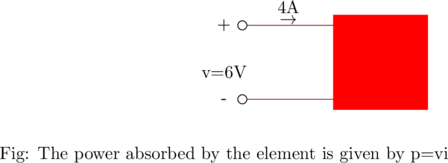Current
As we know, from physics that there are two types of charge, that are positive and negative and We neither can create nor destroy a charge

- A single proton will have a charge +1.602 x

- A single electron will have a charge -1.602 x

Current means a flow of charge and it is denoted by symbol I or i
Current =flow of charge
The SI unit for charge is coulomb(C)
The coulomb is defined in ampere when the total charge that passes through a wire in a one second
So, we can say the unit of current is ampere(A)
1 ampere = 1 coulomb per second
Practical-0: suppose in a wire electrons are flowing to create a current of 2mA. Then determine ![]() and
and ![]()
Solution:
![]() = -2 mA
= -2 mA
![]() = +2 mA
= +2 mA
Practical-1:Convert a current from 200 milliamps to amps
Solution
Milliamps are represented by a symbol I (MA)
Amps are represented by a symbol I(A)
Formula to convert amps(A) = milliamps/1000 =200/1000=0.2A
Practical-2: convert a current from 0.2 amps to milliamps
solution
Formula: milliamps =ampsX1000=0.2X1000=200(MA)
Different types of current
- Direct current (DC)
- Alternating current (AC)
- Exponential current
- Damped sinusoidal current
Direct current(DC)
Direct current(DC) means a current which is constant in time as shown in the below figure

Alternating current (AC)
Alternating current(AC) means a current that varies sinusoidally with time as shown in the below figure
Alternating current is used in the normal day-to-day household switchboards

Short circuit

Short circuit often happens when positive(+) and negative(-) terminals are connected directly due to that current flows in a loop with no resistance
When the current flow without resistance then at that instance, it draw a large current and this causes the path to heat up, melt, batteries even may explode
According to Ohms law
V=IR volts
V=Ix0=0v
The resistance of a short circuit will be zero
Open circuit

Open circuit means when there is no connection between a positive terminal(+) and a negative terminal(-)
To make an open circuit we usually use a switch to break the connection between positive(+) and negative(-) terminal
According to Ohm’s law
I= ![]() =
= ![]() =0A
=0A
The resistance of an open circuit will be ![]()
Close circuit

In close-circuit, current flows from positive(+) to negative (-) with some internal resistance
For example, a light bulb or any other device will have an internal resistance that will limit the current flow through it
Voltage
Voltage means the force that is required to move the charge through the element or else we can say the pressure that is required to move the charge through the element
The unit of voltage is volt
1 volt = 1 J/C
Always voltage is represented with a plus-minus sign and it always exists between a pair of the electrical terminal such as batteries

A circuit element is a shapeless object, which possesses two terminals, by which current can enter or leave the element
We can assume a circuit element as an electrical device such as
- Light bulbs
- Resistor’s
- Transistor’s
- Diode’s
- Capacitor’s
Power
Power means the rate at which energy is spent
The SI unit of power is the watt(W)
We can represent power by equation
P=vi
Where p= power(joules per second)
v= voltage (joules per coulomb)
and i= current (coulombs per second)

From the above figure, terminal A has 6V which means 6V of energy is needed to push each coulomb through the element and to exit from terminal B, on the other hand, if we are injecting 4A then that means
(6 J/C) X (4 C/S) =24 J
In other words, we can say the element is absorbing 24W of power
Ohms law
The ohms law gives the relation between the current(I), the voltage(V), and the resistor(R)
Ohms law: the current flowing through the circuit is directly proportional to the voltage(V) across the circuit and inversely proportional to the resistor of the circuit

In other words, we can say if the current increase in the element then simultanly the voltage also increase and if the current decreases in the element then similarly, the voltage across element will also decrease
If the current value increases across the element then at that instance, the resistance value will decrease Similarly, if the value of current is decreased then at that instance, the value of resistance will be increased

Practical: A 50 ![]() resistance is placed across a 20V battery then find the current through the resistor and power loss?
resistance is placed across a 20V battery then find the current through the resistor and power loss?
Solution:
From the given data
V= 20V R=50 ![]()
I= ![]() =
= ![]() =0.4A
=0.4A
Power loss= ![]() R=
R=![]() X 50= 8W
X 50= 8W
Also power loss = ![]() =
= ![]() =8W
=8W


Leave a Reply